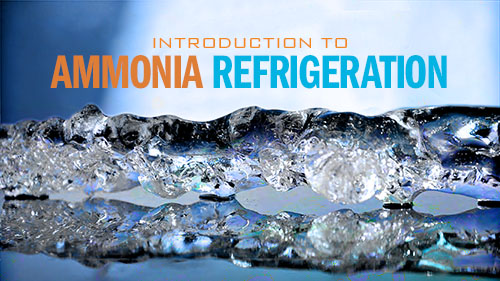Introduction to Ammonia Refrigeration (Digital Leaders Guide)
AMM001-ELG-ENGIntroduction to Ammonia Refrigeration (Streaming Video)
AMM001-STR-ENGIntroduction to Ammonia Refrigeration (Streaming Video)
AMM001-STR-SPN
Ammonia is one of the most common and advantageous refrigerants in the world. But for all its benefits, ammonia in both its liquid and gas forms is potentially hazardous. Acutely toxic, corrosive, and reactive, it can cause death and damage the skin, eyes and respiratory system, especially in highly concentrated levels. It is flammable and explosive under certain conditions, and can destroy equipment that contains zinc, copper, brass, and bronze, as well as various types of plastic and rubber.
Help keep employees safe and prevent refrigeration equipment breakdowns with Introduction to Ammonia Refrigeration, a new training program that examines:
- History and physical composition of ammonia
- Various types of ammonia systems and their components
- Operational dynamics
- Maintenance requirements
- Preventive maintenance protocols
- Safety measures, including PPE
Ammonia is one of the most common and advantageous refrigerants in the world. But for all its benefits, ammonia in both its liquid and gas forms is potentially hazardous. Acutely toxic, corrosive, and reactive, it can cause death and damage the skin, eyes and respiratory system, especially in highly concentrated levels. It is flammable and explosive under certain conditions, and can destroy equipment that contains zinc, copper, brass, and bronze, as well as various types of plastic and rubber.
Help keep employees safe and prevent refrigeration equipment breakdowns with Introduction to Ammonia Refrigeration, a new training program that examines:
- History and physical composition of ammonia
- Various types of ammonia systems and their components
- Operational dynamics
- Maintenance requirements
- Preventive maintenance protocols
- Safety measures, including PPE
Ammonia is one of the most common and advantageous refrigerants in the world. But for all its benefits, ammonia in both its liquid and gas forms is potentially hazardous. Acutely toxic, corrosive, and reactive, it can cause death and damage the skin, eyes and respiratory system, especially in highly concentrated levels. It is flammable and explosive under certain conditions, and can destroy equipment that contains zinc, copper, brass, and bronze, as well as various types of plastic and rubber.
Help keep employees safe and prevent refrigeration equipment breakdowns with Introduction to Ammonia Refrigeration, a new training program that examines:
- History and physical composition of ammonia
- Various types of ammonia systems and their components
- Operational dynamics
- Maintenance requirements
- Preventive maintenance protocols
- Safety measures, including PPE
| SKU | AMM001-ELG-ENG |
| SKU | AMM001-STR-ENG |
| SKU | AMM001-STR-SPN |
| Streaming Video, Digital Leaders Guide | |
| English - US, Spanish | |
| 18 minutes | |
| 18 minutes |
3rd party software may be needed to view the product.